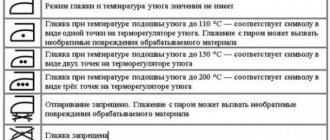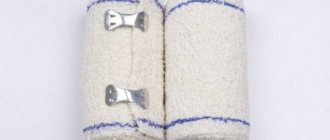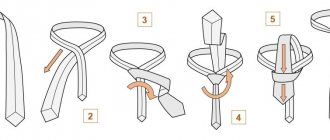A tie is an important component of a men's business suit. Let's talk about how to wash and iron a tie so that it always looks perfect. How else? After all, this is the purpose of a tie.
Oddly enough, ties are less dirty for those men who are used to wearing a tie all the time. A real gentleman does not drop ashes on his tie or pour borscht on his tie in the dining room. But if a man wears a tie rarely, on special occasions, then he sometimes has to wash the tie after each use.
Preparing to wash a men's tie
In order not to ruin a men's tie by washing, you need to prepare for washing. Preparing to wash a tie includes several steps:
- you need to read the information on the tie label - the recommended washing modes are indicated there;
- then determine what material the tie is made of and whether this material is machine washable;
- Check on a small area of the tie to see if the fabric is fading.
If there is a small stain on your tie, you can try removing the stain without washing. Still, it is not recommended to wash ties frequently to preserve their appearance.
Silk men's ties cannot be washed in a washing machine. They are carefully washed by hand in cool water using special detergents for silk products.
If the tie is fading, you should wash the tie by hand in cool water, without soaking, and quickly. Such a tie made of fadeable fabric should be dried in a well-ventilated place, spread out, for example, on a terry towel.
Setting the iron mode
Only an iron with a steam function will do. It is better to apply steam from a distance of at least 10 cm from the wrinkled item. The iron should be heated according to the manufacturer's recommendations. They are indicated on the tie label.
It is advisable to keep the temperature slightly lower than the recommendations on the label. Then the material will last longer.
Before ironing, set the “Steam” function on the iron, set the appropriate temperature and fill a special reservoir with water.
How to wash a tie by hand
If the tie is very dirty, soak it in warm water with washing powder for 40 minutes. Then gently wash the tie by hand or with a soft brush. After washing, rinse the tie several times in clean water.
To maintain the brightness of the color, you can add a little salt to the powder in the washing water.
After washing and rinsing, the tie should not be wrung out or twisted. Shake the water off the tie and lay it on a terry towel to absorb excess water.
Proper drying
After washing, ties made of thick synthetic fabric can be hung on the balcony like regular laundry. However, they should be protected from sunlight - the pigment fades under the influence of ultraviolet radiation. Black, blue and red products are the most vulnerable.
It is better to dry silk and other thin ties lying down, and certainly on a towel. The latter absorbs excess water, which significantly speeds up the process. If such objects are hung on a rope, they will become deformed.
Removing stains from a men's tie
After festive events, traces of alcohol may remain on your tie. The most unpleasant and persistent ones come from red wine. You can try removing wine stains with salt:
- Sprinkle fresh stain with salt;
- wash the tie in soapy water.
When washing a men's tie, do not use chlorine-containing products. To remove stubborn lipstick or ink stains, you can use special non-chlorine stain removers.
Handwash
First you need to check whether the tie is fading. To do this, take wet cotton wool and rub it a little on the back side. There should be no marks left on the cotton wool. If so, then you can start washing. To properly wash a tie, you must have a powder for delicate items or a colorless shampoo (soap without dyes is suitable).
- From thick and dense cardboard, you need to cut a stencil along the contour of the tie and put it inside the product so that it does not wrinkle during washing and the fibers of the fabric do not fray. Pre-wrap the stencil with film to prevent the cardboard from getting wet.
- Sew along the edges with a thin thread.
- Pour warm water into a basin (the water should not be hot) and add laundry detergent.
- Soak the tie for 30-40 minutes.
- Gently rub the contaminated areas with a sponge or tightly compressed cotton wool. The product must not be stretched.
- Place under running cold water.
- Remove the stencil.
- The product cannot be squeezed. You need to wait until all the water drains by itself.
- You need to hang it to dry, pressing the tip with a clothespin.
How to iron a man's tie
If the tie is well straightened and dried after washing, you don’t need to iron it. But if it gets wrinkled, you can iron the tie through a layer of damp gauze or thin cotton cloth, or use a steamer.
When ironing, you need to set the iron to the minimum temperature and iron the tie in one direction.
If you wash your tie correctly, it will look dignified and elegant.
Is it possible to iron a tie?
Due to frequent ironing, the appearance of the tie risks deteriorating, so it is better to use alternative methods:
- Purchase a special steamer for delicate wardrobe items. The electrical device gently straightens the fabric with steam; it is small in size and can be taken with you on a business trip.
- Twist the tie into a tube and unwrap it after 10-12 hours. The method works if the accessory is slightly dented.
- Hang it in the bathroom before taking a hot shower. The steam will gently straighten out rough creases.
If these methods do not help, only an ironing board will help return the wrinkled item to a neat appearance - you will have to use an iron.
Recommendations
Washing a tie requires care, increased attention and strict adherence to the instructions on the product label.
The following tips will provide additional assistance in caring for your item:
If the tag to the item has not been preserved, it is advisable not to use machine washing, but to treat care as correctly and carefully as possible.- Hot water is not acceptable for washing any ties.
- To rinse a tie, you should use water at a temperature that is not in contrast to that used for washing.
- For rinsing, you can use lightly salted water (50 grams of salt per 2 liters of water). This will help better preserve the freshness of the item and the brightness of the colors.
- If you don’t have a steamer or an iron at hand, rolling it up like a snail and leaving it like that for at least the whole night will help solve the problem with ironing. But this smoothing option will be ineffective if the item is excessively wrinkled.
- When washing, it is advisable to avoid prolonged contact of the product with water.
If stains on things are a frequent problem, then it is recommended to purchase a high-quality stain remover that can help combat difficult stains.
Removing stains
You cannot squeeze the tie by twisting it: this accessory must dry naturally, and to do this, just leave it on a terry towel, unfolding it to its full length. To speed up the process, place a second towel on top, and under no circumstances should you leave the tie to dry in the sun.
But it’s not easy to put it in water: the tie must be placed on the bottom of the container being used in a horizontal position, straightened along its entire length and strictly horizontally. After thirty minutes, during which the soaking occurs, it should be gently rubbed with your hands, and if the dirt is too strong, you can wash it with a soft sponge.
Bearded questions: How to part a man's head
Iron a tie only through gauze, but it is better to use a thin towel for this. If you are still afraid of ruining the fabric and are not sure that you can handle ironing, you can use two safer methods:
In household chemical stores you can find special stain removers that are applied to the tie with a cotton pad or napkin for just a few minutes, but strong or old stains cannot be removed this way.
If there is dirt on the item, it must be removed first. You can remove stains using special products or available home remedies like baking soda and hydrogen peroxide. With this treatment, it is necessary to sprinkle the contaminated area with baking soda, pour vinegar over it and leave overnight; in the morning, remove the applied mixture from the tie.
It’s quite possible to wash your tie yourself at home. It is necessary to follow some recommendations when washing such a product.
Methods for removing different types of contaminants
To start washing your tie, you should have on hand:
– detergent for delicate washing;
- ball pen. To remove such a stain you will need hydrogen peroxide. Apply it to a cotton sponge and lightly wipe the problem area. Then rinse the tie in room temperature water and dry.
Functional cookies help to perform certain functionalities like sharing the content of the website on social media platforms, collect feedback, and other third-party features.
Analytical cookies are used to understand how visitors interact with the website. These cookies help provide information on metrics the number of visitors, bounce rate, traffic source, etc.
It is also permissible to dry such items on a horizontal surface that has been previously covered with a clean cloth or terry towel. But here you need to make sure that the bedding under the tie is perfectly level. Otherwise, the shape of the product may be deformed.
So that your tie is always in order
- After wearing, the tie must be loosened;
- The product must be stored by hanging it on a special hanger, and it should not come into contact with other things. These hangers are made of material that prevents items from sliding off the bars. This method will preserve the appearance of the product for a longer period than if you store it on a shelf.
- If you don’t have a special hanger, you can roll the accessory. Then she won’t get wrinkled and will be attractive longer.
- When tying a tie, do not tighten the knots too much to avoid excessive wrinkles.
Let your appearance always be attractive and elegant!
Source
MEN'S SHIRTS
The shirt should be moderately damp and the iron should be well heated for ironing to be as effective as possible.
When ironing the cuffs, be sure to unbutton them, straighten them on the ironing board and iron them on both sides.
Start ironing from the collar, straightening it well and ironing it first from the inside and then from the outside. When ironing the cuffs, be sure to unbutton them, straighten them on the ironing board and iron them on both sides.
Then you can move on to the sleeves using a special small board. Finally, iron the shirt tails and back, paying special attention to buttons and openings, ironing them thoroughly.
CORRECT IRONING TECHNOLOGY
You need to iron from right to left, starting from the wide part of the item towards the narrow part. You should move the iron along a straight thread along and across the fabric, otherwise you may stretch it unevenly. Items cut on the bias are also ironed along the grain.
When ironing, do not pull the fabric. The item needs to be laid out evenly, the way it should look when finished. First of all, small details are ironed: sleeves, collars, cuffs, pockets, embroidery, lace. Clothes made of dark fabric are always ironed inside out.











